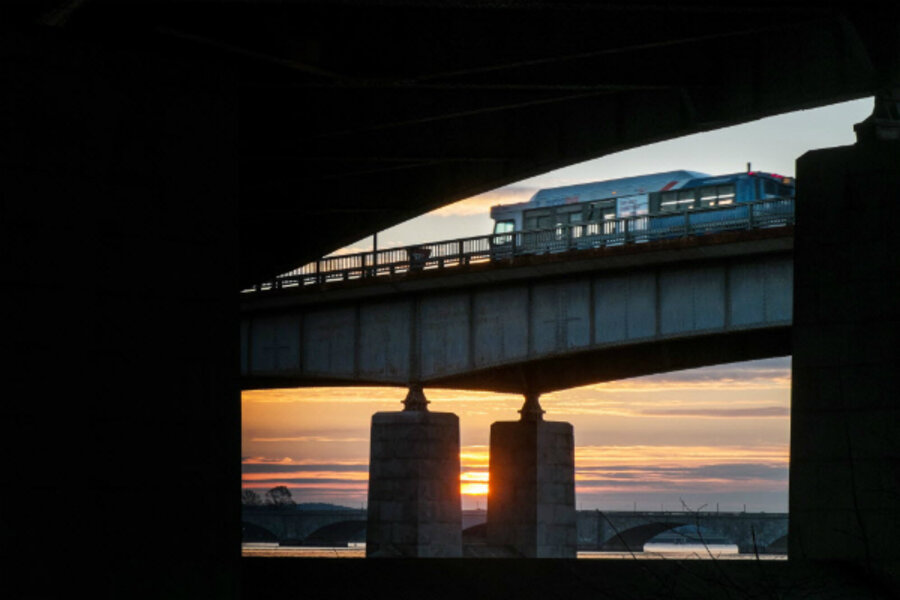Public transportation makes a comeback, but not in Boston
Loading...
| Boston
Americans took more trips on public transportation in 2013 than in any other year in more than five decades, according to the American Public Transportation Association’s annual report, released Monday.
That’s 10.7 billion trips on buses, trains, and subways – the highest number since 1956, back when Americans were heavy users of big-city transit because they were more likely to live in town than in outlying (and car-reliant) suburbs. Americans’ use of public transit also increased from 2012 to 2013 by about 1 percent, with most of the gains in use of heavy rail, including subways and elevated trains, according to the report.
But the higher numbers of people turning to public transportation aren't just the result of population increase or the cost of a tank of gasoline.
Public transit ridership has outpaced population growth since 1995, with public transportation use up by about 37.2 percent compared with population growth of 20.3 percent. Plus, the rise in ridership is despite a drop in gas prices in recent years. The number of public transport trips last year surpassed the 10.59 billion trips taken in 2008, even as gas prices have come down from about $5 a gallon to about $4, upending the assumption that high public transportation use is tied to gas price increases, according to The New York Times.
Even so, “four dollars is still high” for a gallon of gasoline, says Jose Gomez-Ibanez, professor of urban planning and public policy at Harvard University’s Kennedy School of Government, adding that high rates of public transportation use can be pinned to some degree on the continued expense of filling up the tank.
The boom in public transportation use likely owes a lot to better economic times, the report said. Almost 60 percent of all rides taken on public transportation are work-related, according to the report, and as urban downtowns burn brighter, more workers are commuting to and from them.
The increase might also be related to boosted federal and local investment in public transportation projects, as US cities tug their communities together with new lines and added stations, and overhaul their systems with expanded schedules.
“There’s a wider perception that there’s a major public benefit to public transportation,” says Professor Gomez-Ibanez. “You can’t imagine any of these big cities operating if everyone drove their car.”
In Miami, where subway use was up almost 11 percent, the city had recently increased train frequencies during peak hours, the report said. And in Salt Lake City, where commuter rail ridership jumped by 103.3 percent, the city had cut the ribbon on a new commuter rail line in December 2012, according to the report.
Still, increases were not across the board. Public transportation use was down in Chicago, Baltimore, and Detroit, among others. In Boston, where public transportation use declined about 1 percent, just heavy rail – not including the subway system's Green Line, which is counted under light rail – saw small gains in ridership.
The decline in Beantown was a surprising blip in what has been an overall rise in Boston public transit use for the past decade, by about 1.2 percent a year, says Stephanie Pollack, associate director of the Kitty & Michael Dukakis Center for Urban and Regional Policy at Northeastern University in Boston.
Some of that decline might be a consequence of a major fare hike that has since been scaled back, she says. But it also could be an early sign that Boston's public transportation system is losing riders as improvements fail to keep pace with needs and expectations, she says.
The decline from 2012 to 2013 is “not a crisis,” says Ms. Pollack, “but it is a warning sign.”
“One concern is that the age and disrepair of the T is catching up with ridership,” she says. “This really reinforces the need to invest in the system.”
Some improvements have been or will be made. The MBTA has begun replacing threadbare cars on the subway's Red and Orange lines and plans to expand Green Line service to Somerville, which abuts Boston, over the next several years. It also has plans for new stations along its commercial rail service lines, and on Monday it reopened the Yawkey commuter rail station, adding 20 trips a day between Boston and Worcester, Mass., about 40 miles away.
Still, with not enough funds to go around, the MBTA has postponed plans to overhaul its Green Line, which had a derailment Monday morning and has been troubled with overcrowding and delays, says Pollack. Bus service also runs too infrequently for many riders to depend on it, and the MBTA is not slated to get more buses for three more years, she says.
[Editor's note: The original version of this article misstated the timeline for the Green Line expansion project.]








